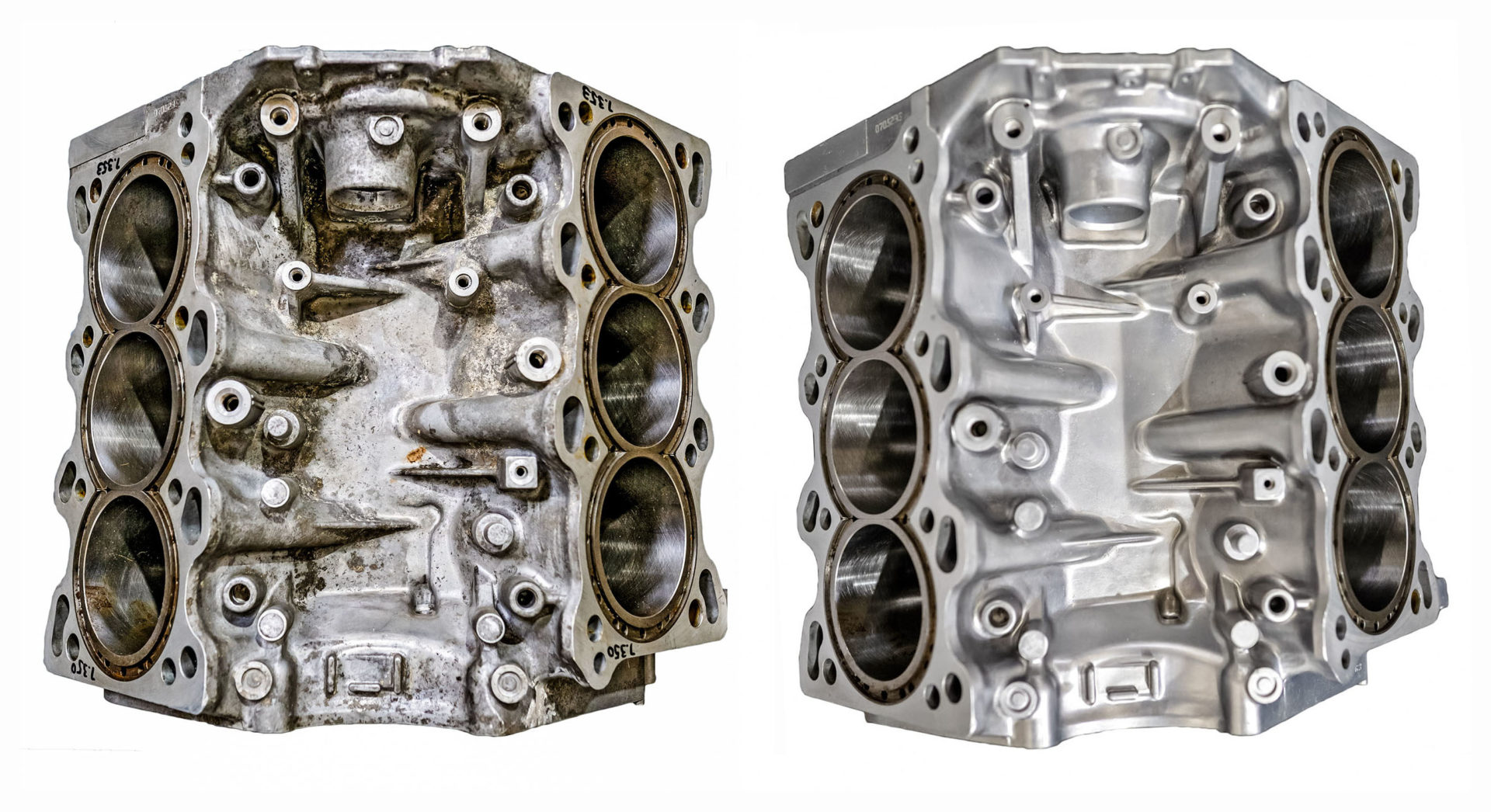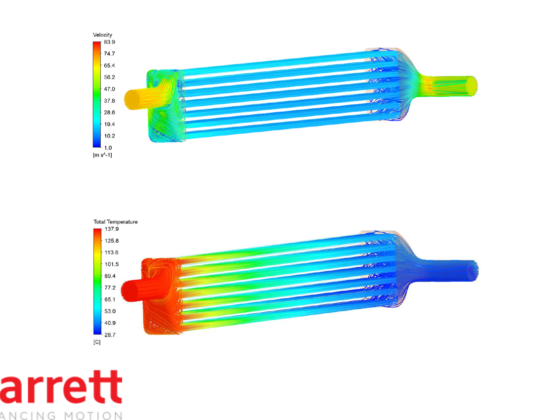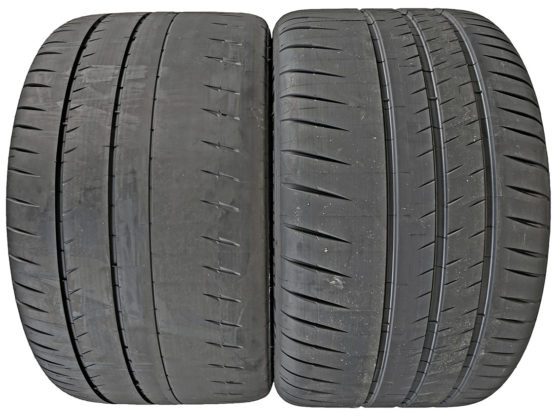Traditional chemicals, parts washers, and hot tanks can only do so much to clean dirty car parts. When pride is taken in rebuilding anything from a carburetor to an entire engine or suspension, simply cleaning the surface of the metal is just not enough. Thankfully there is a process that is quickly increasing in popularity that restores surfaces to better than new condition: Vapor Blasting / Wet Blasting.

We recently took a tour around Mountune USA’s facility (located in Carson, California), and were introduced to the amazing process known as Vapor Blasting. Once we saw the end result of the process, we had to take a few parts from Project NSX to get blasted.

Mountune USA is the US-branch of the British tuning company founded by David Mountain (Mountain-Tune) and made famous for their championship winning touring car and rally race engines. The US division is made up of a lot of ex-Cosworth guys who know a thing or two about building engines. While known for their work on Ford twin-cam engines, Mountune USA is a complete engine development facility with a machine shop, assembly room, and an in-house engine dyno. They are the official engine builder of the Honda-powered F4 championship and their engine shop is full of Porsche engines, vintage car engines, and more.
WHAT IS VAPOR BLASTING?
Vapor blasting goes by many different names: Wet blasting, wet abrasive blasting, aqua blasting, slurry blasting, wet sandblasting, dustless blasting, and liquid honing. It is a surface refinishing process that effectively removes coatings, contaminants, corrosion and residues without damaging the original surface. Because of this, vapor blasting is quickly becoming the number one choice for applications, like restorations, that require the highest quality surface finish.

Vapor blasting is a superior process with significant advantages over traditional dry sandblasting. By suspending fine abrasive media in water and detergents, the blasted surface is left with an attractive satin finish that is smooth and almost polished due to a peening-effect that doesn’t leave fingerprints like sandblasted parts do, while being more resistant to future staining and corrosion.
 Dry blasting uses sheer impact force from high-pressure compressed air to propel abrasive media at a surface. This process causes the media to shatter on impact into finer dust particles, distorts and embeds abrasive particles into the substrate, generates heat, and can cause dry sparks charged with static electricity.
Dry blasting uses sheer impact force from high-pressure compressed air to propel abrasive media at a surface. This process causes the media to shatter on impact into finer dust particles, distorts and embeds abrasive particles into the substrate, generates heat, and can cause dry sparks charged with static electricity.
 By comparison, in vapor blasting, the water/detergent solution softens the impact of the abrasive media and adds mass to the particle at impact. This creates a hydrostatic force that blasts away surface coatings and imperfections, scrubbing the surface clean by the flow of water borne abrasives, without embedding the media into the substrate. This process produces a lapping effect across the surface; knocking down the high points of the surface to improve the uniformity and smoothness of the surface. This is part of what gives vapor blasted components the smooth, polished, satin finish. Softening the impact also prevents the particles from shattering and cleans the surface without damaging or changing the surface itself.
By comparison, in vapor blasting, the water/detergent solution softens the impact of the abrasive media and adds mass to the particle at impact. This creates a hydrostatic force that blasts away surface coatings and imperfections, scrubbing the surface clean by the flow of water borne abrasives, without embedding the media into the substrate. This process produces a lapping effect across the surface; knocking down the high points of the surface to improve the uniformity and smoothness of the surface. This is part of what gives vapor blasted components the smooth, polished, satin finish. Softening the impact also prevents the particles from shattering and cleans the surface without damaging or changing the surface itself.
 Not only is this process cleaner and dust-free, but more importantly, vapor blasting can operate at lower pressures to remove coatings, contaminants, and corrosion without damaging the underlying substrate from erosion or distortion. The water also reduces friction and localized heat that can warp metal surfaces in normal dry blasting. This makes vapor blasting the preferred method for restoring antiques, soft surfaces such as aluminum, copper, brass, bronze and even wood.
Not only is this process cleaner and dust-free, but more importantly, vapor blasting can operate at lower pressures to remove coatings, contaminants, and corrosion without damaging the underlying substrate from erosion or distortion. The water also reduces friction and localized heat that can warp metal surfaces in normal dry blasting. This makes vapor blasting the preferred method for restoring antiques, soft surfaces such as aluminum, copper, brass, bronze and even wood.

Overall, vapor blasting is a far less aggressive (but equally effective) form of blasting that restores the finish to better than new conditions. It cleans the surface like no other process could, while creating a finish that gives the look and feel of a high quality restoration.




18 comments
Love doing this at home with a bag of baking soda and a pressure washer!
How well does that work? Can it remove heavy corrosion and baked on carbon? Does a pressure washer develop enough pressure? Doesn’t the baking soda dissolve? I also believe that wet soda blasting does not leave the beautiful surface finish. I am pretty sure simply putting baking soda in a pressure washer isnt going to give you anywhere near these results.
Baking soda works well, but not mixed with water. I use a siphon gun for soda blasting but it must be dry
After further research I found that baking soda can be used wet, but I’m not sure I’d want to run anything like that through my pressure washer.
I saw on youtube that soda blasting does not leave anywhere near as nice of a finish and doesnt appear to clean as well either. Looks like it takes a lot longer too.
Dry soda blasting is one of the least effective methods at removing tough surface contaminates. It’s mostly for cleaning. The big advantage of wet blasting is the ‘cushioning’ of the impact of the media. Since that’s not really a problem to begin with for soda blasting, and due to soda’s effect when mixed with water, it’s not exactly the same benefit as wet blasting harder media like glass and sand.
How does it compare to sand blasting with respect to removal of all media after processing? A piece of sand in an oil gallery can be catastrophic!
Of course you have to clean the block carefully like you would in any good engine build.
I don’t blast major engine parts because it’s just too hard to clean everything, and even then there is no way to check. My local machine shop has a water based, heated cleaning cabinet that really works well.
A company I worked for 50 years ago had a vapor blaster, it’s not a new tech.
Many machine shops nowdays for iron blocks uses baking and shot peening instead of hot tanking. Also for aluminum, wash cabinet and walnut blasting. You always have to remove all galley plugs and brush them out, not just spray them out. Its SOP when building engines. We never have problems. You also mask everything off before blasting. SOP. Wet blasting has been around for awhile but these newer machines with different types of media that give such nice surface finishes are new to our industry.
I like the shiny finish this leaves on the surface. Makes me wonder how this will do on steel.
Great article featuring our customers! If you would like to know more about vapor blasting, visit our website: https://www.vaporblastingequipment.com/ they use our Aquablast 1215.
Is this what was used in project binky when they cleaned the transmission p parts?
Yes, yes it was.
Would you apply a top coat to keep oxidation from setting in? Its now raw alum and would oxidize quickly.
It doesn’t oxidize nearly as quickly as a dry blasted part because of there being less surface contaminants and the surface less porous, but yeah it would still need a coating of some type if you want it to stay looking like this long term. Expect it to be about the same as bare polished metal.
1. I’m curious as to why some machined surfaces need to be taped and others not? There are a lot of gasket, bearing, and seal surfaces being blasted here, but not the deck surface for the head.
2. What kind of post vapor blasting cleaning needs to be done? Does the wet media need to be rinsed out? Is that part of the service Mountune offers? Or do you have to use hot, soapy water and brushes, after?
3. Are the internals of engine cases and various galleys every blasted? E.g., to remove the various hues of baked on engine oil.
4. There are quite a few different alternative names mentioned for this process. Aside from using Mountune’s services how would I know someone else is using the same process even if they use a different name?
Awesome results. What size glass bead is used and at what pressure air ?